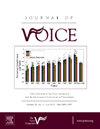Factors Affecting the Lifetime of Third-Generation Voice Prosthesis After Total Laryngectomy
IF 2.5
4区 医学
Q1 AUDIOLOGY & SPEECH-LANGUAGE PATHOLOGY
引用次数: 0
Abstract
Purpose
The study aimed to evaluate the impact of different variables on the longevity of Voice Prosthesis (VP) in patients after total laryngectomy.
Patients and Methods
This retrospective cohort study is based on data about a continuous series of 328 third-generation VP, which were implanted between 2016 and 2020. Data about the VP users’ age, sex, place of residence, laryngeal tumor stage, neck irradiation, VP size, and the use of Heat and Moisture Exchanger (HME) were obtained and analyzed. The effect of these variables on VP lifetime was determined.
Results
The median lifetime of VPs in patients 65 years old and above was 182 days (95% CI 168-196), versus 146 days (95% CI 130-162) (P = 0.033) in patients younger than 65. Neck irradiation was associated with a longer VP median lifetime of 161 days (95% CI 142-180) compared to 126 days (95% CI 100-152) with no prior neck irradiation (P = 0.046). HME usage was associated with significantly increased longevity of VPs: 182 days (95% CI 156-208) with HME and 149 days (95% CI 132-166) without HME usage (P = 0.039).
Conclusion
The results of the present study suggest that neck irradiation, and routine use of use of HME are positively associated with the longevity of VPs.
影响全喉切除术后第三代嗓音假体使用寿命的因素
目的:本研究旨在评估不同变量对全喉切除术后患者嗓音假体(VP)寿命的影响:这项回顾性队列研究基于2016年至2020年间植入的328例第三代VP的连续系列数据。研究获取并分析了VP使用者的年龄、性别、居住地、喉肿瘤分期、颈部照射情况、VP尺寸以及热湿交换器(HME)使用情况等数据。结果表明,这些变量对VP寿命的影响:结果:65 岁及以上患者的 VP 寿命中位数为 182 天(95% CI 168-196),而 65 岁以下患者为 146 天(95% CI 130-162)(P = 0.033)。颈部照射与更长的 VP 中位生存期有关,前者为 161 天(95% CI 142-180),后者为 126 天(95% CI 100-152)(P = 0.046)。使用 HME 与 VP 寿命的显著延长有关:使用 HME 的 VP 寿命为 182 天(95% CI 156-208),而未使用 HME 的 VP 寿命为 149 天(95% CI 132-166)(P = 0.039):本研究结果表明,颈部照射和常规使用 HME 与 VP 的寿命呈正相关。
本文章由计算机程序翻译,如有差异,请以英文原文为准。
求助全文
约1分钟内获得全文
求助全文
来源期刊

Journal of Voice
医学-耳鼻喉科学
CiteScore
4.00
自引率
13.60%
发文量
395
审稿时长
59 days
期刊介绍:
The Journal of Voice is widely regarded as the world''s premiere journal for voice medicine and research. This peer-reviewed publication is listed in Index Medicus and is indexed by the Institute for Scientific Information. The journal contains articles written by experts throughout the world on all topics in voice sciences, voice medicine and surgery, and speech-language pathologists'' management of voice-related problems. The journal includes clinical articles, clinical research, and laboratory research. Members of the Foundation receive the journal as a benefit of membership.
 求助内容:
求助内容: 应助结果提醒方式:
应助结果提醒方式:


